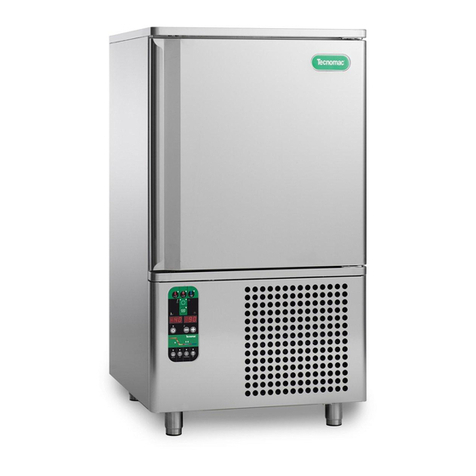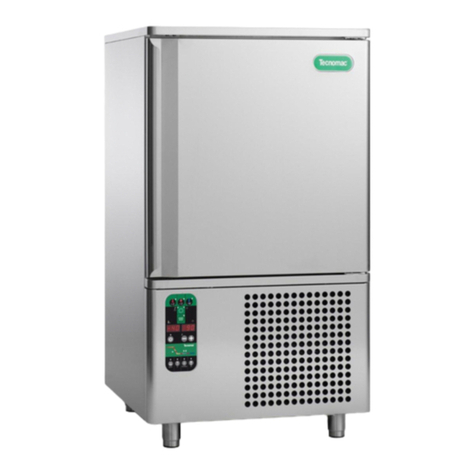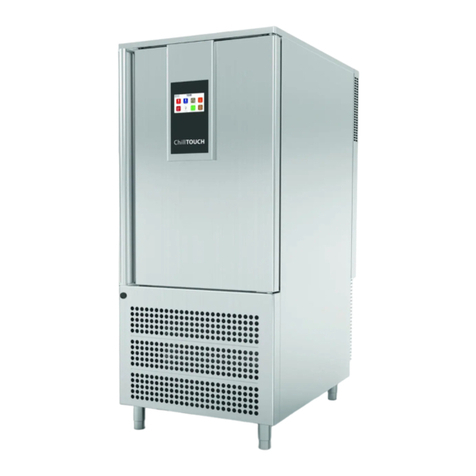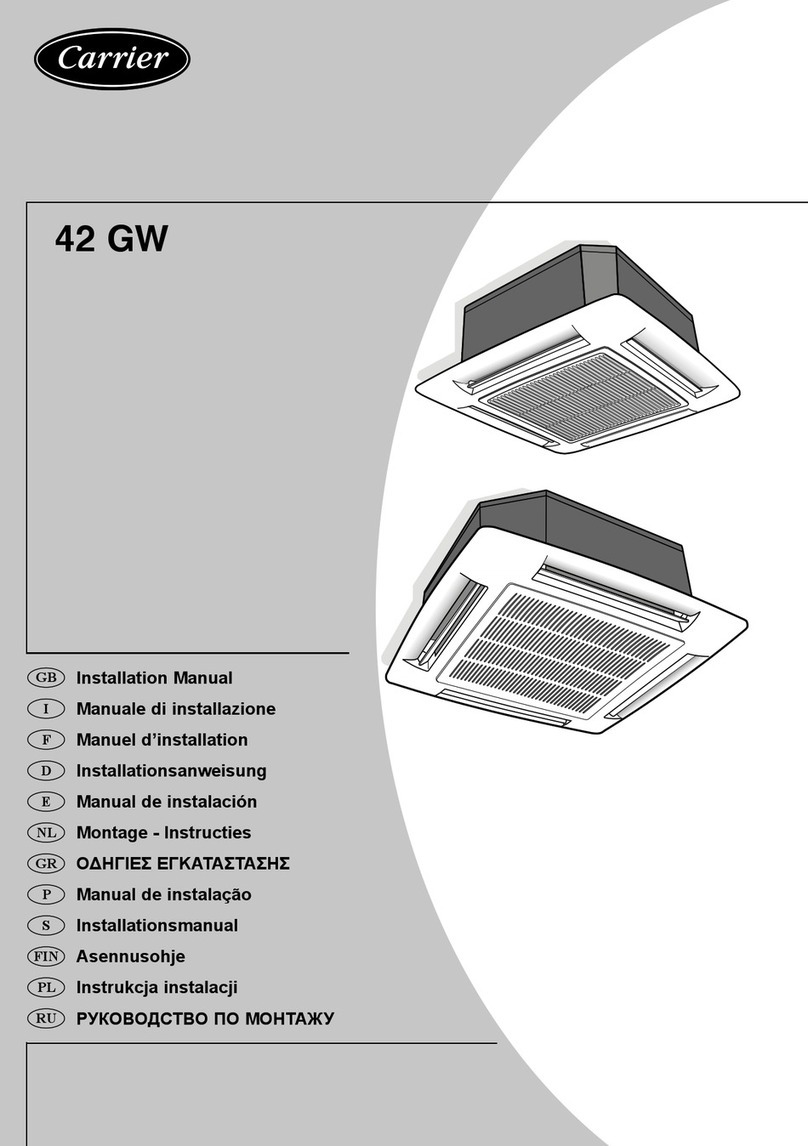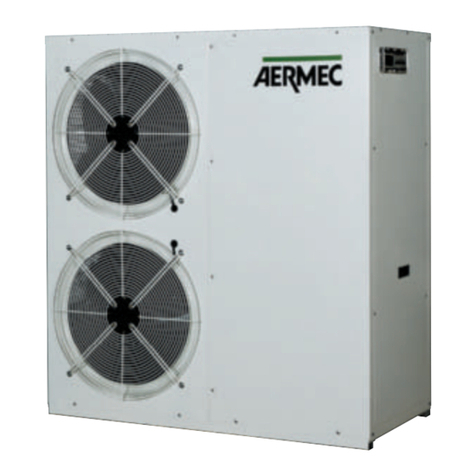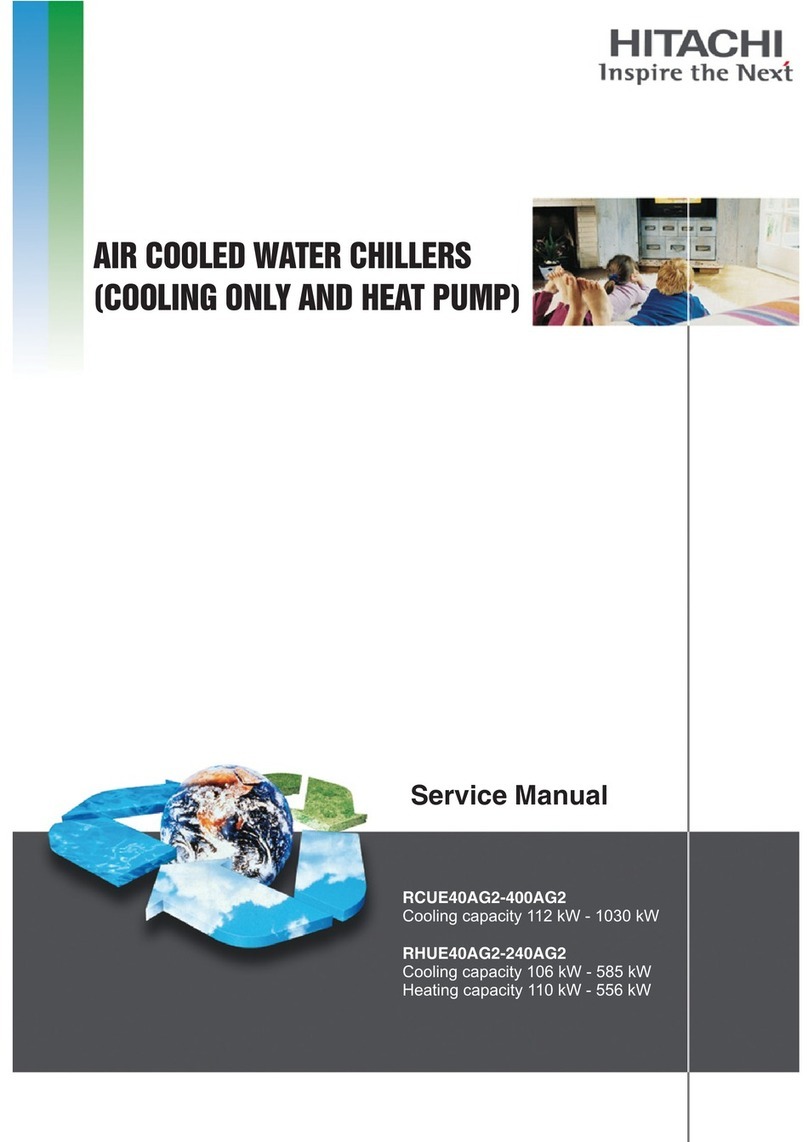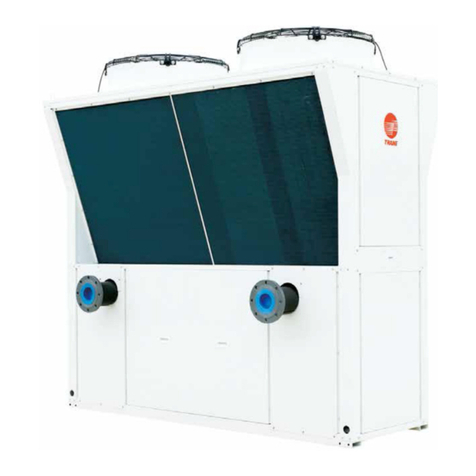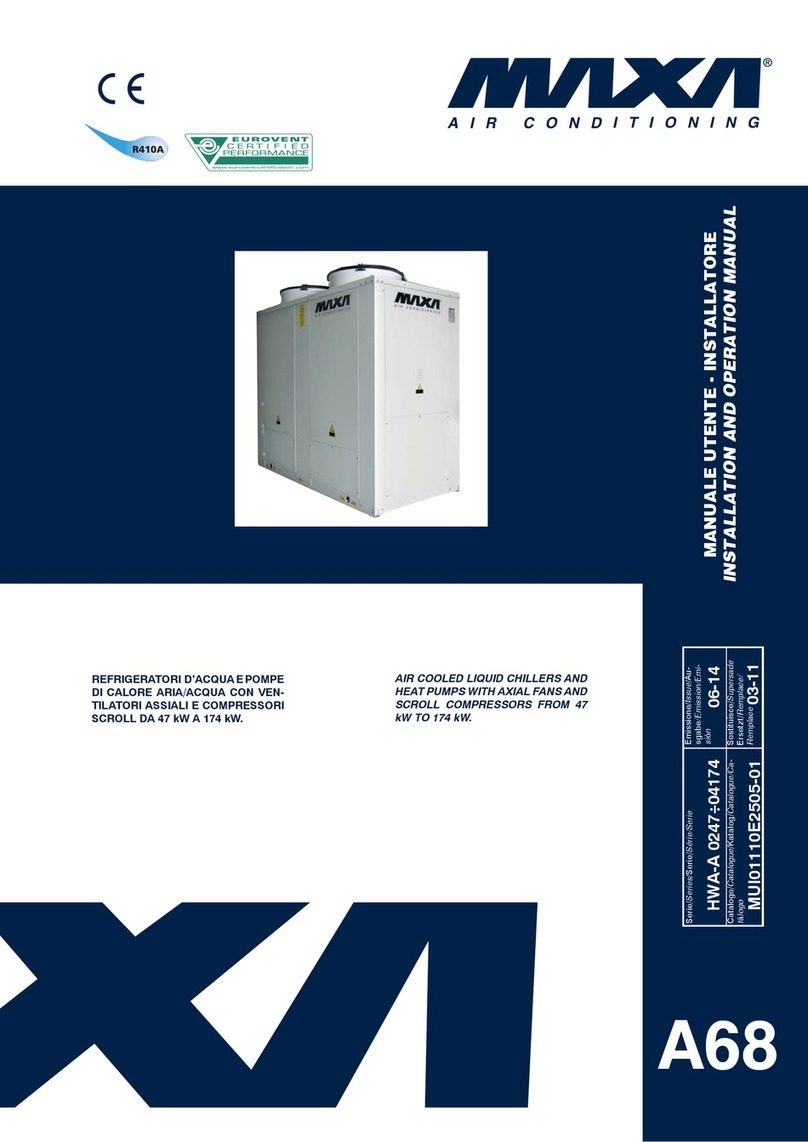Tecnomac BK+ 5.16 A User manual

Blast Chillers
Instruction manual
BK+5 BK+10 BK+15
EasyChill
ChillRapid
SurRapid

Gentile Cliente,
La ringraziamo per aver preferito uno dei
nostri prodotti, frutto di lunga esperienza
e di una continua ricerca per un prodotto
superiore in termini di affidabilità,
prestazioni e sicurezza.
In questo manuale troverà tutte le
informazioni ed i consigli per poter
utilizzare il suo prodotto nel massimo
della sicurezza ed efficienza.
Dear Customer,
We would like to thank you for having
chosen our products, the result of long
experience and continuous research for a
superior product in terms of reliability,
performance and safety.
This manual will supply all of the
information and advice for the efficient
use of your product in complete safety.
Cher Client,
Nous vous remercions d’avoir choisi notre
produit, fruit d’une longue expérience et
d’une recherche permanente d’un produit
supérieur en termes de fiabilité, de
prestations et de sécurité.
Dans ce manuel vous trouverez toutes les
informations et les conseils pour pouvoir
utiliser votre produit avec une sécurité et
une efficacité optimales.
Sehr geehrter Kunde!
Wir danken Ihnen für Ihre Wahl eines
unserer Produkte, welches das Ergebnis
einer langen Erfahrung und stetiger
Forschungsarbeit ist. Dank dieser konnte
ein Produkt entwickelt werden, das ein
hohes Maß an Verlässlichkeit,
Leistungsfähigkeit und Sicherheit bietet.
In diesem andbuch finden Sie sämtliche
Informationen und Ratschläge, damit Sie
das Produkt mit maximaler Sicherheit und
Effizienz nutzen können.
Estimado cliente:
Le agradecemos por elegir nuestros
productos, fruto de la gran experiencia y
de la investigación constante para
obtener un producto superior en
términos de fiabilidad, rendimientos y
seguridad.
En este manual, encontrará todos los
datos y consejos para poder utilizar el
producto en sus máximos niveles de
seguridad y eficiencia.

L’apparecchio contiene gas fluorurati ad effetto serra disciplinati dal protocollo di Kyoto
The equipment contains greenhouse effect fluoride gas governed by the Kyoto protocol
L’appareil contient des gaz fluorés à effet de serre règlementés par le protocole de Kyoto
Das Gerät enthält fluorierte Treibhausgase durch das Kyoto-Protokoll fallen
El aparato contiene gases fluorados de efecto invernadero regulados por el protocolo de Kioto
REGOLAMENTO (UE) 2015/1095
REGULATION (EU) 2015/1095
RÈGLEMENT (UE) 2015/1095
VERORDNUNG (EU) 2015/1095
REGLAMENTO (UE) 2015/1095
REGULAMENTO (UE) 2015/1095
РЕГЛАМЕНТ (ЕС) 2015/1095
NAŘÍZENÍ KOMISE (EU) 2015/1095
KOMMISSIONENS FORORDNING (EU) 2015/1095
KOMISJONI MÄÄRUS (EL) 2015/1095
ΚΑΝΟΝΙΣΜΟΣ (ΕΕ) 2015/1095 ΤΗΣ ΕΠΙΤΡΟΠΗΣ
UREDBA KOMISIJE (EU) 2015/1095
KOMISIJAS REGULA (ES) 2015/1095
KOMISIJOS REGLAMENTAS (ES) 2015/1095
A BIZOTTSÁG (EU) 2015/1095 RENDELETE
REGOLAMENT TAL-KUMMISSJONI (UE) 2015/1095
VERORDENING (EU) 2015/1095 VAN DE COMMISSIE
ROZPORZĄDZENIE KOMISJI (UE) 2015/1095
REGULAMENTUL (UE) 2015/1095 AL COMISIEI
NARIADENIE KOMISIE (EÚ) 2015/1095
UREDBA KOMISIJE (EU) 2015/1095
KOMISSION ASETUS (EU) 2015/1095,
KOMMISSIONENS FÖRORDNING (EU) 2015/1095
Modello
Models
Modèles
Modelle
Modelos
Alimentazione
Power supply
Source de courant
Energieversorgung
Fuente de alimen-
tación
Refrigerante
Refrigerant
Fluide frigorigène
Kühlgas
Fluido refrige-
rante
Carica refrigerante
Refrigerant charge
frigorigène
Kältemittelfüllung
Carga de refrigerante
(Kg)
GWP
Ciclo Abbattimento Positivo - Chilling Cycle - Cycle Chilling
Kühlzyklus - Ciclo de enfriamiento
Ciclo Abbattimento Negativo - Freezing Cycle - Cycle de Congélation -
Gefrierzyklus - Ciclo de congelación
Ciclo temperat.
Temp. Cycle
Cycle de temp.
Temperaturzyklus
Ciclo de temperat.
(°C)
Capacità
Capacity
Capacité
Kapazität
Capacidad
(Kg)
Durata ciclo
Cycle time
Temps de cycle
Taktzeit
Tiempo de ciclo
(min)
Consumo Energia
Energy Consumpt.
Conso. Energie
Energieverbrauch
Cons. de energía
(kWh/Kg)
Ciclo temperat.
Temp. Cycle
Cycle de temp.
Temperaturzyklus
Ciclo de temperat.
(°C)
Capacità
Capacity
Capacité
Kapazität
Capacidad
(Kg)
Durata ciclo
Cycle time
Temps de cycle
Taktzeit
Tiempo de ciclo
(min)
Consumo Energia
Energy Consumpt.
Conso. Energie
Energieverbrauch
Cons. de energía
(kWh/Kg)
BK+ 5.16 A 220-240V/50Hz R404A 1,10 3922 +65° / +10° 18,4 103 0,098 +65° / -18° 13,8 266 0,337
BK+ 5.16 W 220-240V/50Hz R404A 1,10 3922 +65° / +10° 18,4 103 0,098 +65° / -18° 13,8 266 0,337
BK+ 10.30 A 220-240V/50Hz R404A 2,40 3922 +65° / +10° 33,6 98 0,091 +65° / -18° 23,0 265 0,361
BK+ 10.30 W 220-240V/50Hz R404A 2,00 3922 +65° / +10° 33,6 98 0,091 +65° / -18° 23,0 265 0,361
BK+ 15.40 A 400V/3N/50Hz R404A 2,20 3922 +65° / +10° 41,4 102 0,100 +65° / -18° 27,6 258 0,379
BK+ 15.40 W 400V/3N/50Hz R404A 2,20 3922 +65° / +10° 41,4 102 0,100 +65° / -18° 27,6 258 0,379

BLAST C ILLER ISTRUCTION
BUTT NS AND LEDS
q
w
e
r
t
y
u
q
w
e
r
t
y
u
i
o
a
s
d
f
Start/Stop
Cycle status
Soft/hard positive blast chilling button (+3°c)
Blast freezing button (-18°c)/ice cream cycle
Blast chilling mode
Decrease value key
Increase value key
STATUS ICONS
Door alarm LED
Timed cycle LED (yellow)
Temperature cycle LED (yellow)
Positive blast chilling cycle LED (green)
ard blast chilling cycle LED (yellow)
Blast freezing cycle LED (green)
Storage cycle LED (green)
Defrosting phase LED (green)
igh pressure alarm LED (red)
Minutes LED (red)
Temperature scale LED (blue)
Cell sensor alarm LED
Evaporator sensor alarm LED
quytrew

PREFACE
• This manual is an integral part of the pro-
duct, providing all the information required
to ensure correct installation, operation and
maintenance of the machine.
•ead the manual carefully, making refe-
rence to it for machine operation. Keep the
manual in a safe place where it can be ac-
cessed by all authorised operators (instal-
lers, operators and service personnel).
• Installation must be performed in com-
pliance with National and Local Standards,
by professionally qualified staff and accor-
ding to the manufacturer's instructions.
• Any contractual and extra-contractual lia-
bility of the manufacturer is excluded due
to damage caused by errors during instal-
lation and use and, however, failure to com-
ply with the National and Local Standards
in force and the instructions supplied by
the manufacturer.
• Make sure that the supplied or specified
components are used.
• Before performing any cleaning or mainte-
nance operation, disconnect the appliance
from the electric power supply mains by
operating on the system switch and/or the
product switch.
•
In the event of faults and/or bad functio-
ning, deactivate the appliance and do not
attempt any repairs or direct intervention.
CAUTI N
THE F LL WING PERATI NS
AND TH SE HIGHLIGHTED
BY THIS SYMB L MUST N T BE
PERF RMED BY THE APPLIANCE USER
In particular:
• Electrical connections
• Water connections
• Installation
• Testing
• Repairing machine components
• Disassembly of the appliance
and/or its components
• Adjustments and calibration
• Cleaning the appliance and maintenance of:
- Electrical parts,
- Electronic parts,
- Mechanical parts,
- Refrigeration system parts
THE TEXT WITH THIS SYMB L
IS F PARTICULAR IMP RTANCE
R P TENTIAL DANGER SIGNALS
N TA claries the current operations
i

English
1
BLAST C ILLER ISTRUCTION
1. GENERAL DOCUMEN A ION
1.1 GENERAL INFORMATION . . . . . . . . . . . . . . . . . . . . . . . . . . .2
1.2 INSTALLATION . . . . . . . . . . . . . . . . . . . . . . . . . . . . . . . . . . . . .2
1.3 TRANSPORTATION AND MOVING . . . . . . . . . . . . . . . . . .2
1.4 UNPACKING DISPOSAL OF PACKAGING . . . . . . . . . .2
1.5 SAFETY STANDARDS . . . . . . . . . . . . . . . . . . . . . . . . . . . . . . .2
2. INS ALLA ION
2.1 PLATE DATA . . . . . . . . . . . . . . . . . . . . . . . . . . . . . . . . . . . . . . . .3
2.2 NOTIFICATION OF MALFUNCTION . . . . . . . . . . . . . . . . .3
2.3 POSITIONING . . . . . . . . . . . . . . . . . . . . . . . . . . . . . . . . . . . . . .3
2.4 ROOM TEMPERATURE AND VENTILATION . . . . . . . . . .3
2.5 ELECTRICAL CONNECTION . . . . . . . . . . . . . . . . . . . . . . . .3
2.5.1 Connecting the equipment to the mains . . . . . . . . . . .3
2.6 REMOTE REFRIGERATOR UNIT CONNECTION . . . . . . .4
2.7 DRAIN CONNECTION . . . . . . . . . . . . . . . . . . . . . . . . . . . . . .4
2.8 NOTES FOR T E INSTALLER . . . . . . . . . . . . . . . . . . . . . . . .4
2.9 SAFETY AND INSPECTION SYSTEMS . . . . . . . . . . . . . . .4
2.10 DISPOSAL OF T E MAC INE . . . . . . . . . . . . . . . . . . . . . . .4
3. RECOMMENDA IONS FOR PROPER OPERA ION
3.1 S UTDOWN MET ODS . . . . . . . . . . . . . . . . . . . . . . . . . . . .5
3.2 RECOMMENDATIONS FOR USE . . . . . . . . . . . . . . . . . . . . .5
3.2.1 Pre-chilling . . . . . . . . . . . . . . . . . . . . . . . . . . . . . . . . . . . . . . . . .5
3.2.2 Loading the machine . . . . . . . . . . . . . . . . . . . . . . . . . . . . . . .5
4. PROGRAMMING AND OPERA ING INS RUC IONS
4.1 MAC INE STARTUP . . . . . . . . . . . . . . . . . . . . . . . . . . . . . . . .6
4.2 SETTING T E DATE AND TIME . . . . . . . . . . . . . . . . . . . . . .6
4.3 OPERATION . . . . . . . . . . . . . . . . . . . . . . . . . . . . . . . . . . . . . . . .6
4.3.1 Selecting positive blast chilling timed cycle . . . . . . . . .6
4.3.2 Selecting positive blast chilling temperature cycle . .6
4.3.3 Selecting positive hard blast chilling timed cycle . . . .7
4.3.4 Selecting positive hard blast chilling
temperature cycle . . . . . . . . . . . . . . . . . . . . . . . . . . . . . . . . . .7
4.3.5 Selecting freezing timed cycle . . . . . . . . . . . . . . . . . . . . . .7
4.3.6 Selecting freezing temperature cycle . . . . . . . . . . . . . . .7
4.3.7 Quick selection of positive blast chilling
indefinite timed cycle . . . . . . . . . . . . . . . . . . . . . . . . . . . . . .8
4.3.8 Selecting ice cream hardening /
freezing indefinite timed cycle . . . . . . . . . . . . . . . . . . . . . .8
4.4 DRYING CYCLE . . . . . . . . . . . . . . . . . . . . . . . . . . . . . . . . . . . . .8
4.5 RAPID DISPLAY OF TIME
AND TEMPERATURE VALUES . . . . . . . . . . . . . . . . . . . . . . .8
4.6 SANITIZING CYCLE OPTIONAL . . . . . . . . . . . . . . . . . . . .8
5 PARAME ERS
5.1 PARAMETER MODIFICATION ACCESS . . . . . . . . . . . . . .9
5.2 PARAMETER LIST . . . . . . . . . . . . . . . . . . . . . . . . . . . . . . . . . . .9
5.3 DEFROSTING MANAGEMENT . . . . . . . . . . . . . . . . . . . . . .9
5.4 USB DATA RECORDER OPTIONAL . . . . . . . . . . . . . . . . .9
6. GREA ECHNOLOGY AND PROCESS VALUE
6.1 "SOFT" BLAST C ILLING . . . . . . . . . . . . . . . . . . . . . . . . . .10
6.2 " ARD" BLAST C ILLING . . . . . . . . . . . . . . . . . . . . . . . . . .10
6.3 QUICK FREEZING . . . . . . . . . . . . . . . . . . . . . . . . . . . . . . . . .10
7. ALARMS LIS . . . . . . . . . . . . . . . . . . . . . . . . . . . . . . . . . . . . . . . . .11
8. ORDINARY MAIN ENANCE
8.1 ELEMENTARY SAFETY STANDARDS . . . . . . . . . . . . . . .12
8.2 CONDENSER CLEANING . . . . . . . . . . . . . . . . . . . . . . . . . .12
8.3 CELL CLEANING . . . . . . . . . . . . . . . . . . . . . . . . . . . . . . . . . .12
8.4 EXTERNAL MAINTENANCE AND CLEANING . . . . . . .12
8.5 DEFROST WATER DRAINING . . . . . . . . . . . . . . . . . . . . . .13
Description Page Description Page
INDEX

English
2BLAST C ILLER ISTRUCTION
1. GENERAL D CUMENTATI N
1.1 GENERAL INF RMATI N
• This manual is an integral part of the product, providing all
the information required to ensure correct installation, ope-
ration and maintenance of the machine.
• Read the manual carefully, making reference to it for machine
operation. Keep the manual in a safe place where it can be
accessed by all authorised operators (installers, operators and
service personnel).
The machine has been constructed in compliance with the
directives 73/23/CEE (low-voltage), 89/336/CEE (electroma-
gnetic compatibility) and 98/37/CE (machines; for certain
models only).
• The machine has been designed for professional applications
only and should only be operated by qualified personnel.
• The machine must only be used for the purposes for which
it was designed, i.e. for chilling and freezing food products.
The machine must not be used for products requiring con-
stant temperature control and recording, such as:
- heat-sensitive chemicals,
- medicines or
- blood products.
• The manufacturer declines all responsibility for any damage
caused by incorrect or unreasonable machine use, such as:
- improper use by untrained persons;
- technical modifications or operations not suited to specific
models;
- use of non-original or non-specific spare parts;
- failure to follow the instructions given in this manual.
• This appliance is not intended for use by persons -including
children- with reduced physical, sensory or mental capabili-
ties, or lack of experience and knowledge, unless they have
been fiven superfision or instruction concerning use of the
appliance by a person responsible for their safeti. Children
should be supervised to ensure that they do not play with
appliance.
1.2 INSTALLATI N
• The machine must be installed by a specialised technician
authorised by and in compliance with the instructions given
in this manual.
In the event that the machine is fitted with a remote con-
denser unit, the installation technician is responsible for
checking all connections in compliance with the instructions
given by for plant and machine installation.
1.3 TRANSP RT AND HANDLING
• To load or unload the machine and/or components
from/onto the means of transport, use a lift truck or fork lift
equipped with forks that are at least half the length of the
machine housing; use a crane if the machine is fitted with
eye bolts. Select the lifting equipment suited to the weight
and overall dimensions of the packaged machine/compo-
nents.
• When handling the machine/ components, apply all precau-
tions to prevent damage, in compliance with the information
given on the packaging material
1.4 UNPACKING
• Remove all cardboard, wood or other materials from the
wood base on which the machine is set. Lift the
machine/components with suitable means (e.g. lift truck), re-
move the wood base, then position the machine / compo-
nents in the allocated site.
• Once all packing material has been removed, check that the
machine has not been damaged in any way.
• Remove the protective PVC film on the stainless steel panels
from all internal and external surfaces.
Always wear protective gloves when handling packing
material and the wood base.
Nota: Dispose of packing materials in compliance with isposal
regulations applie in the country where the machine is to be
installe . Never ispose of materials in the environment. (see sec-
tion 2.9).
1.5 GENERAL SAFETY REGULATI NS
Failure to observe the recommendations made by the pre-
sent manual will be at the entire responsibility of the ma-
chine user. The main safety regulations are as follows:
• do not touch the machine with moist or wet hands or feet;
• never operate the machine while barefoot;
• do not insert screwdrivers, cooking utensils or any other
object between the guards and moving parts;
• before performing cleaning or routine maintenance ope-
rations, disconnect the machine from the power supply at
the master switch and the main knife switch (if present);
• never pull on the power cable to disconnect the machine
from the power supply.
i

English
3
BLAST C ILLER ISTRUCTION
2. INSTALLATI N
2.1 DATA PLATE INF RMATI N
• Check that the data specified on the plate correspond to the
characteristics of the power supply (V, kW, z, no. phases and
power available).
• The dataplate with appliance specifications is located at the
rear exterior of the machine and/or on the electrical boards.
The set-up of individual
units and the installation of
condensers are subject to
the fire-safety regulations of
the country in which the
machine is installed; seek all
necessary advice from the
local fire-fighting authori-
ties.
Bear in mind that the intervention of safety valves or plug
fuses in the refrigerating circuit will lead to the immediate
discharge of refrigerant into the environment.
2.2 REMARKS / MALFUNCTI N’S CLAIMS
In case of machine malfunctioning and claim on Blast Chil-
lers delivered in the following way :
• Assembled
We ask you to indicate to the dealer / service: machine
model, machine code number and apparatus serial number.
These information are written on the registration label, instal-
led on the back of machine and inside the door.
• Disassembled
We ask you to indicate to the dealer / service: machine
model, machine code number and apparatus serial number.
These information are written on the registration label, instal-
led on top of the control panel.
2.3 P SITI NING
• The machine must be installed and commissioned in com-
plete compliance with safety regulations, procedures and
standing laws.
• The installation technician bears the responsibility of ensu-
ring compliance with fire safety requirements; seek all neces-
sary advice from the local fire-fighting authorities.
• Position the machine in the allocated site.
• Adjust the machine feet until the appliance is perfectly level.
In the case of particularly heavy equipment, use appropriate
lifting means (fig. A - Cap. 1.3).
• If the appliance is not perfectly level, correct operation and
condensate flow-off will not be assured.
Avoid
• direct exposure to sunlight;
• closed sites with high temperatures and poor air circulation;
• installing the machine near sources of heat.
2.4 AMBIENT TEMPERATURE AND AIR CIRCULATI N
For air-cooled appliances, the maximum ambient tempera-
ture for operation is 32°C. Correct operation cannot be gua-
ranteed at higher temperatures.
The machine may operate safely to a maximum temperature
of 38°C.
Remote condensing units must be installed in special rooms
or outdoors, protected against direct sunlight by a shelter or
roof structure (at the cost of the purchaser).
Sufficient air circulation must be guaranteed at all times.
2.5 ELECTRICAL C NNECTI NS
A dedicated thermal-magnetic circuit breaker compliant
with established regulations must be installed on the ap-
pliance power line.
• Connected electrical cables must correspond to the techni-
cal data (as specified on electrical drawings provided by the
installation technician).
Connect the earthing conductor to an efficient earthing sy-
stem.
The manufacturer declines all liability and guarantee obli-
gations in the event of injury to persons or damage to
equipment and objects due to incorrect installation and/or
failure to comply with standing installation regulations.
2.5.1 Connecting the appliance to the power supply
In the event of damage to the power supply cable on the ap-
pliance, have the cable replaced only by a qualied electri-
cian to avoid any risk of personal injury
THESE PERATI NS MUST BE
PERF RMED BY A CERTIFIED
INSTALLATI N TECHNICIAN NLY
Serial
~ Hz AW
kg
WW
W
38Ø-4ØØ/3N 5Ø 1Ø 3ØØØ
Machine model AX8 ØØØ 1Ø3 Ø3213
R4Ø4 A 2.2 CLASS T
11
IP 21

English
4BLAST C ILLER ISTRUCTION ST
2.6 REFRIGERATION COM ONENT CONNECTIONS
REMOTE ASSEMBLIES
Appliance power lines are sized for installation distances of
up to 10 metres. For greater distances, seek advice from.
2.7 CONDENSATE DRAINAGE CONNECTION
Fit a condensate/wash water drainage hose with a minimum
diameter of 1” (“Geberit” or similar type).
Provide a waste pipe with a
trap with a diameter of at least
1 1/2” at floor level.
2.8 INFORMATION FOR THE INSTALLATION TECHNICIAN
Before starting up the machine, check that it has been cor-
rectly installed and commissioned (test report).
1. Check that there are no gas leaks from weldings or joints
made during installation works.
2. Check that the pipes connecting the condenser to the re-
mote condensing unit have been well insulated.
3. Check all wiring connections.
4. Check electrical input.
5. Check the standard pressure in the refrigerant system.
6. Check the water connections and efficiency of the pressure
switch valve during operation, as well as the flow of conden-
sing water (in water-cooled units).
7. Perform at least one blast freezing cycle (to the SET tempe-
rature) and one manual defrosting cycle.
In the event that the appliance or the remote condensing
unit have not been transported in a vertical position (e.g. on
the back) or have been overturned during installation works,
allow at least 4 hours before starting up the equipment.
• Inform the customer of the exact purpose of the appliance,
with specific reference to the use and requirements of the
customer.
The appliance must be installed and put into service by a
technician authorised.
2.9 SAFETY AND CONTROL SYSTEMS
• Door microswitch:
shuts down fan operation in the cell when the door is ope-
ned.
• General fuses:
protect the power circuit against short circuiting and over-
loads.
• Compressor heat relay:
intervenes in the event of overloads or operating faults.
• Safety pressure switch:
intervenes in the event of excessive pressure in the refrige-
rant circuit.
• Plug fuses:
intervene in the event of overpressure or operating fault in
the safety pressure switch (see above).
• Chamber temperature control:
operated by the electronic board by means of a probe inside
the cell.
• Temperature control end defrost cycle:
controlled by the electronic board by means of the probe in
the evaporator.
2.10 DIS OSAL OF WASTE ELECTRONIC AND ELECTRICAL
EQUI MENT (WEEE)
The following information regards member states of
the EU. The crossed-out litter bin symbol indicates
that the product cannot be disposed of as residential
waste. Ensuring that this product is disposed of
correctly will help prevent potential negative effects
on the environment and to human heath that could be
caused if disposed of in an incorrect manner.

English
5
BLAST C ILLER ISTRUCTION
3. ADVICE T ENSURE EFFICIENT APPLIANCE PERATI N
3.1 SHUTD WN PR CEDURES
In the event of emergency, shut down the appliance by swit-
ching off power at the main panel, by means of the knife
switch or by removing the plug from the power socket.
3.2 PERATING TIPS
Before starting up the appliance, clean the inside of the cell
thoroughly.
3.2.1 Pre-cooling
Before using the appliance for the first time, or after a pro-
longed period of disuse, pre-cool the cell by running an
empty cycle until the set operating temperature has been
reached.
To ensure optimal performance without any alteration to
food quality:
• arrange food products in such a way as to favour the circula-
tion of cold air throughout the cell;
• open the door as little as possible.
3.2.2 Loading the appliance
a) Ensure that foods to be chilled and/or frozen are separate
and do not have a thickness greater than 50-80 mm. Do not
load the appliance beyond the quantity recommended by
the manufacturer.
b) Ensure that there is sucient clearance between trays to ena-
ble free air circulation.
If the appliance is not completely full, distribute the trays and
foods evenly throughout the available space.
c) Position trays inside the tray compartment as far as they will
go, as close as possible to the evaporator.
d) Position the core probe at the centre of the largest product
or food item; make sure that the tip of the probe does not
protrude or touch the tray.
The probe must be cleaned and sanitised before each new
cycle (operation) to prevent inadvertent contamination.
e) Avoid covering the trays and/or containers with insulating
covers or film. The more the product is insulated, the more
time is required for chilling or freezing.
Trays must be packaged when the product has been chilled,
before being placed in storage.
0.5 - 2cm.

English
6BLAST C ILLER ISTRUCTION
4. PROGRAMMING AND OPERA ION INS RUC IONS
4.1 MACHINE STARTUP
Power the machine up
The machine can be in:
•STANDBY.
With the machine off, the display is as follows (the keys/unlit
symbols in gray), the cell probe values are displayed:
•OFF Condition
With the machine shut down, to move to the off status, press
the Start/Stop button qfor at least 3".
• to exit the off status press the Start/Stop button q(the only
enabled button) for at least 3".
4.2 SETTING THE DATE AND TIME
Turn the machine off by holding the Start/Stop button qfor
3". Then hold the freeze button rdown for 3".
•The year (YY) will appear, which can be changed using the
up uand down ybuttons. Confirm using the freeze button
r.
• Then the month (nn), day (dd), hour (hh) and minutes
(no) appear in succession, also modifiable with the up u
and down ybuttons. Confirm the data each time with the
freeze button r.
• Once the minutes have been confirmed, it exits the clock set-
ting function and returns to the OFF condition.
Note: in case of ALARM RTC on the isplay it’s necessary to
provi e to set the time.
4.3 PERATI N
It is recommended always to pre-cool the machine the
first time blast-chilling or deep freezing is performed.
The work cycle is optimized in this way by reducing the
time (see chap. 4.3.7).
4.3.1 Selecting positive blast chilling timed cycle
With the machine in standby, select the positive blast chilling
button e; the display will show the value 90 min.
To increase or decrease the blast chilling time, use the up u
and down ybuttons.
To start the positive blast chilling timed cycle, press the
Start/Stop button q. When the cycle starts, the time will
begin to count down.
The arrows on the left hand side wflash during blast chilling
and are steady during the storage phase. The machine may
be stopped at any time by pressing the Start/Stop button q
for 3 seconds.
Once the blast chilling time has expired, it will automatically
go into storage mode.
In the storage phase the cell temperature will be displayed.
4.3.2 Selecting positive blast chilling temperature cycle
With the machine in standby, select the positive blast chilling
button e. The display will show the value 90 min.
To select the temperature mode press the blast chilling
mode button eand the default value appears: +3°C
Use the up uand down ybuttons to increase or decrease
the end blast chilling temperature.
Insert the product inside the blast chiller making sure to po-
sition the probe on the product.
To start the positive blast chilling temperature cycle, press
the Start/Stop button q. The arrows on the left hand side w
will flash during chilling and will be steady during the storage
phase.
The machine may be stopped at any time by pressing the
Start/Stop qbutton for 3 seconds
Once the set blast chilling temperature has been reached,
the machine will automatically go into storage mode.
In the storage phase the cell temperature will be displayed
i
IN HE EVEN OF A MALFUNC ION,
CALL HE CER IFIED ECHNICIAN
3 sec

English
7
BLAST C ILLER ISTRUCTION
4.3.3 Selecting positive hard blast chilling timed cycle
With the machine in standby, select the positive blast chilling
button etwice. The display will show the value 90 min with
the prefix h, indicating that the hard cycle was selected.
To increase or decrease the blast chilling time, use the up u
and down ybuttons.
To start the positive blast chilling timed cycle, press the
Start/Stop button q. At the beginning of the cycle, the time
will begin to count down. The arrows on the left hand side
w will flash during chilling and will be steady during the
storage phase.
The hard symbol twill flash during the second phase of the
hard cycle. The machine may be stopped at any time by hol-
ding the Start/Stop button qdown for 3 seconds
On the end of the ard cycle the system goes automatically
in positive preservetion phase.
In the storage phase the cell temperature will be displayed.
Note: the uration of the har phase is han le automatically
by the Blast chiller. The perio of har phase is etermine au-
tomatically in percentage by the parameter set in the factory
un er passwor .
The uration of the har phase will be 66% of the time setting.
Ex: setting the total time of har chilling at 100 ', the har phase
will be har to 66 ', while the soft phase will be 34'.
4.3.4
Selecting positive hard blast chilling temperature cycle
With the machine in standby, select the positive blast chilling
button eTWICE, the display will show the value 90 min,
with the prefix h.
To select the temperature mode, press the blast chilling
mode button
t
and the default value will appear: +3°C
Use the up uand down ybuttons to increase or decrease
the blast chilling temperature.
Insert the product inside the blast chiller making sure to po-
sition the probe on the product.
To start the positive hard blast chilling temperature cycle,
press the Start/Stop button q. The arrows on the left hand
side wwill flash during chilling and will be steady during the
storage phase.
The machine may be stopped at any time by pressing the
Start/Stop button qfor 3 seconds
Note: the har chilling at temperature works in the first phase
at negative temperature in the cell, until the core probe will e-
tect a temperature at core of 15 ° C.
A this point the chilling will pass to the secon phase of the cycle
with a higher temperature in the cell until the nee le probe e-
tects a temperature in the pro uct of +3 °C.
Then the chiller will pass to preservation phase
Once the set blast chilling temperature has been reached in
the product core, the machine will automatically go into sto-
rage mode.
In the storage phase the cell temperature will be displayed.
4.3.5 Selecting blast freezing timed cycle
With the machine in standby, select the freezing button r,
the display will show the value 240 min.
To increase or decrease the freezing time, use the up uand
down ybuttons.
To start the freezing timed cycle, press the Start/Stop button
q. At the beginning of the cycle, the time will begin to count
down. The arrows on the left hand side wwill flash during
chilling and will be steady during the storage phase. The ma-
chine may be stopped at any time by pressing the Start/Stop
button qfor 3 seconds
Once the freezing time has expired, the machine will auto-
matically go into storage mode.
In the storage phase the cell temperature will be displayed.
4.3.6 Selecting blast freezing temperature cycle
With the machine in standby, select the freezing button r,
the display will show the value 240 min.
To select the temperature mode, press the blast chilling
mode button
t
and the default value will appear - 18°C.
To increase or decrease the freezing time, use the up uand
down ybuttons.
Insert the product inside the blast chiller making sure to po-
sition the probe on the product.
To start the freezing temperature cycle, press the Start/Stop
button q. The arrows on the left hand side wwill flash du-
ring freezing and will be steady during the storage phase.
The machine may be stopped at any time by pressing the
Start/Stop button qfor 3 seconds
Once the set freezing temperature has been reached in the
product core, the machine will automatically go into storage
mode.
In the storage phase the cell temperature will be displayed.
i
i

English
8BLAST C ILLER ISTRUCTION
4.3.7 Quick selection of positive blast chilling indefinite timed
cycle
With the machine in standby, select the positive blast chilling
button efor at least 3", a positive cycle for an indefinite
amount of time will start immediately, and POS will appear
on the display.
The arrows on the left hand side wwill flash during blast
chilling and won't go into storage mode, the blast chiller will
cycle around the minimum cell temperature set for the blast
chilling time cycle. The machine may be stopped at any time
by pressing the Start/Stop button qfor 3 seconds
4.3.8 Selecting the ice cream hardening / freezing indefinite
timed cycle
This function will allow the user to use the blast chiller using
the following method:
With the machine in stand-by, select the freezing cycle; the
button rlights up. Then press the freezing button rfor 3
seconds, the first LED will show the letter tand the time set
for the hardening cycle will flash (time given by the Pt4 pa-
rameter). An indefinite timed freezing cycle will start imme-
diately.
The user can modify the hardening cycle time using the up
uand down ybuttons while the time is flashing, and only
at this time.
When the user opens the door (to put the ice cream in) and
then closes it, a beep will sound confirming that it is closed
and the countdown will start. The display will show the coun-
tdown time without flashing.
When the time arrives at zero, the buzzer will sound for 60
seconds and the count remains at zero and flashes. Any time
the door is closed, the countdown is interrupted and a new
one starts. The display is used as a timer while the cycle is on-
going and guarantees negative temperatures in the cell. The
user can interrupt this function by pressing the Start/Stop
button qfor 3 seconds.
4.4 DRYING CYCLE
Selecting drying and forced ventilation
With the machine in standby, select by pressing with a single
pulse the down button y; Air will be flashing on the display.
Drying is timed. To stop it in advance, press the down button
y. Opening the door does not affect the drying cycle
4.5 RAPID DISPLAY F TIME AND TEMPERATURE VALUES
With the machine in operation, the following operation va-
lues can be seen:
•Total time set for a Positive Soft/HardTimed Cycle wr:
Pressing the positive blast chilling button ewill display the
total time set initially for 5", in flashing mode.
•Final temperature set for a Positive Soft/Hard Tempera-
ture cycle er:
Pressing the positive blast chilling button ewill display the
final set temperature for 5" in flashing mode.
•Total time set for a Freezing Timed Cycle wy:
Pressing the freezing button rwill display the total time set
initially for 5" in flashing mode.
•Final temperature set for a Freezing Temperature Cycle
ey:
Pressing the freezing button rwill display the final set tem-
perature for 5" in flashing mode.
•Probe temperature in a Blast Chilling/Freezing cycle:
Pressing the blast chilling type button tduring a blast chil-
ling/freezing temperature cycle, will display the probe tem-
perature for 5 seconds.
•Time elapsed during a blast chilling cycle:
Pressing the down button yduring a blast chilling cycle will
display the amount of time elapsed for 5 seconds in flashing
mode.
•
Cell sensor temperature during a blast chilling cycle:
During any blast chilling cycle, pressing the up button udi-
splays the value of the cell sensor for 5" and then the evapo-
rator sensor for 5", if enabled (if there is a buzzer alarm, it also
silences the alarm).
4.6 SANITIZING CYCLE (optional)
If the password controlled parameters are enabled, a time-
controlled sanitizing cycle may be started. To activate the sa-
nitizing cycle, the equipment must be in off mode. Then,
pressing the up button ufor 3 seconds activates the saniti-
zing cycle, the set minutes will appear on the display and the
countdown will begin, once it is completed it automatically
deactivates and returns to the off position.
To stop the sanitizing cycle early, just press the Start/Stop
button qfor 3 seconds and it will go to standby mode.
If the door is opened, it will immediately deactivate and
can only be reactivated in off phase.
Before starting the sanitizing cycle, proceed as follows:
• remove products from the interior
• thoroughly clean with warm water and neutral detergent
• close the door
• start the cycle.
Use of this cycle is recommended only when processing has
completed.
3 sec
3 sec
3 sec

English
9
BLAST C ILLER ISTRUCTION
5. PARAME ERS
5.1 PARAME ER MODIFICA ION ACCESS
The parameters can be accessed only when the machine is
off. Just press the blast chilling button tfor three seconds,
PASS will appear on the display and the up u, down
yand blast chilling mode buttons twill light up.
Pressing only the up uand down ybuttons accesses only
the user parameters.
To scroll through the parameters, press the up uand down
ybuttons. To make changes, once the parameter has been
selected, press the blast chilling mode button tand
change the parameter value using the up uand down y
buttons. To confirm the value and exit modification mode,
press the blast chilling mode button t.
5.2 LIS OF PARAME ERS
Following is the list of available parameters
5.3 DEFROS ING MANAGEMEN (only in certain models)
Manual defrosting is started by pressing the Defrost button
yfor 3 seconds when the panel is in standby. Manual de-
frosting is shut off by pressing the on/off button qfor 3 se-
conds
5.4 USB DATA REC RDER ( PTI NAL)
• The USB data recorder will register into a .txt file all the data
during the cycles of the machine: Blast Chilling or Freezing
and also during conservation phase.
• The data is registered every minute and will include:
- Date and time
- Cabinet Temperature
- Core probe Temperature
- Type of Cycle
- Start and Stop of Cycle
- Door openings
- Alarms
• The data is constantly stored on the internal recorder, and
can be downloaded anytime from the internal recorder in-
troducing a USB pen drive into the plug on the machine.
Instructions to download the data
1. Find on the machine the USB plug and insert the USB pen
drive
2. IMP RTANT: wait until the led of the pen drive stops fla-
shing, which means that all the data is recorded on the pen
drive.
3. Extract the pen drive
4. On the pen drive you will find a file named log00n000001.txt
which is a text file, delimited with “;” (semicolon).
• The best way to see the data on the file is using Microsoft
Excel, following this sequence:
- Launch Microsoft Excel
- Go to “open file”
- Select “text file” on the type of file
- Open the file registered on the pen drive
- Select “Delimited” file
- Select as delimitator the semicolon “;”
• As an alternative you can open the file with a normal text edi-
tor
• Every time you insert the pen drive, a new log file will be ge-
nerated, with a progressive number (log00n000002.txt,
log00n000003.txt, log00n000004.txt, etc).
• Every file generated will contain the complete historical data
recorded, up to the moment of insertion of the pen drive. So
every time the file is bigger.
• As a consequence, the time to save the file on the pen drive
(see point 2.) will increase from some seconds to several mi-
nutes, depending on how much data is stored on the recor-
der. IT’S VERY
WAIT NTILL ALL THE DATA IS RECORDED ON THE PEN
DRIVE BEFORE REMOVING IT, WAITING NTIL THE LED ON
THE PEN DRIVE STOPS FLASHING.
When updating data: time, day, and year on the board of
the computer, it’s necessary to remove and then restore the
power supply to allow the change data is also stored in the
SB recorder.
3 sec
Parameter Min Max U. M. DEF
P0 Choose temperature unit of measure (0 = Fahren-
heit, 1 = Celsius) 0 1 1 Fla
g
Adjustment set point
Pr1 Blast chilling cell set point -20 30 -5 °C
Pr2 Positive storage cell set point -20 30 +3 °C
Pr3 Freezing cell set point -50 20 -40 °C
Pr4 Negative storage cell set point -50 20 -25 °C
Pr6 End blast chilling product temperature -20 30 +3 °C
Cycle times
Pt0 Max blast chilling temperature cycle duration 1 200 90 min
Pt1 Max freezing temperature cycle duration 1 400 240 min
Pt2
Cycle proposed for startup/after cycle stop:
0 = startup from off, 1 = startup from standby wi-
thout cycle selected,
2 = positive timed, 3 = positive hard timed, 4 = ne-
gative timed, 5 = positive temperature,
6 = positive hard temperature, 7 = negative tem-
perature,
0 7 0 flag
Pt3 After stop cycle offers: 0 = last cycle, 1 = cycle defi-
ned by Pt2, 2 = no cycle 0 2 2 flag
Pt4 Ice cream hardening timer time 1 20 10 min
Pt5 Duration hard time phase (blast chilling cycle %) 1 99 66 min

English
10 BLAST C ILLER ISTRUCTION
6 GREA ECHNOLOGY AND PROCESS VALUE
• Putting freshly cooked food directly in the storage unit is a
mistake! Cooling is static and not very powerful, the chilling
time is too long and bacteria develop rapidly in large quan-
tities.
• Only by using a chilling system with forced ventilation heat
exchange can we be sure that we are preserving the high
initial quality of the food: its appearance, colour, flavour and
aroma.
• Cold, like heat, if not properly managed and metered can vi-
sibly damage food.
• Since every food has its own characteristics, the use of a spe-
cific chilling system every time is important.
Our equipment is characterized by its versatility and the avai-
lability of several functions in the same machine.
- Quick “Soft” blast chilling for delicate products with a redu-
ced thickness.
- Quick “Hard” blast chilling for all dense products, in large
pieces or packaged.
- Quick freezing.
6.1 "SOF " BLAS CHILLING
From +70°C to 3°C at the product core within a maximum of
90 minutes, with air temperature that is always and only po
sitive 0/+2°c, avoiding any type of freezing of the surface
of the food.
6.2 "HARD" BLAS CHILLING
From +70°C to +3°C at the product core within a maximum
of 90 minutes, with variable chamber air temperature auto
matically controlled by the computer. This system allows for
a 2530% time savings in comparison to the "soft" cycle!
6.3 QUICK BLAS FREEZING
function available only in certain models
From +70°c to 18°c at the product core as quickly as possibly
and within at most 4 hours, with a chamber air temperature
of 40°c. Rapid cold penetration prevents the transformation
of water into macrocrystals, thus not ruining the consistency
and integrity of the food.
Each cycle can be manually controlled using the timer or au
tomatically controlled with the food probe. The automatic
storage function at the end of the cycle and the automatic
and manual defrosting cycles complete the exceptional
blast chiller accessories.
Temp.
+70°C
+60°C
+50°C
+40°C
+30°C
+20°C
+10°C
+3°C
0+2°C
-10°C
-20°C
-30°C
-40°C
10 20 30 40 50 60 70 80 90 Tempo
temperature
at the
product core
Processing air
temperature
Temp.
+70°C
+60°C
+50°C
+40°C
+30°C
+20°C
+10°C
+3°C
0+2°C
-10°C
-20°C
-30°C
-40°C
10 20 30 40 50 60 70 80 90 Tempo
temperature
at the
product core
Processing air
temperature
Temp.
+70°C
+60°C
+50°C
+40°C
+30°C
+20°C
+10°C
+3°C
0+2°C
-10°C
-20°C
-30°C
-40°C
0, 30’ 1 2 3 4 ore Tempo
temperature
at the
product core
Processing air
temperature

English
11
BLAST C ILLER ISTRUCTION
7 ALARMS LIS
Note: Faults probes Once the sensor is replace , the alarm i-
sappears after 10 secon s. The sensor alarms at -50°C are isa-
ble uring freezing at -18°C an uring the ice cream
har ening function. Where not specifie , each alarm is accom-
panie by a buzzer (if present). The soun ma e is a five secon
beep that is repeate every 15 secon s. The label in icating the
alarm in progress is alternately isplaye with the current isplay.
ALL Er1 Cell sensor failure
Cause: Outside of operating range
(-50°C / +100°C) for more than 30 seconds with a
blast chilling temperature cycle in progress.
Effect: In standby it prevents startup of blast chilling/
freezing.
In blast chilling/freezing and storage, the cycle is
not blocked and the compressor is activated in cy-
cles (according to the parameters)
eset: check connections and operation of the
cell sensor
ALL Er2 Evaporator Sensor Failure
(only if evaporator sensor is enabled)
Cause: Outside of operating range
(-50°C / +100°C) for more than 30 seconds with a
blast chilling temperature cycle in progress.
Effect: In standby, blast chilling/freezing
and storage, there is no effect.
Any defrost will end due to a timeout.
eset: check connections and operation of the evapora-
tor sensor
ALL Er3 Product Probe Failure
Cause: Outside of operating range
(-50°C / +100°C) for more than 30 seconds with a
blast chilling temperature cycle in progress.
Effect: In standby it prevents startup of temperature con-
trolled blast chilling/freezing. In temperature con-
trolled blast chilling/freezing it causes a change
over to a timed cycle. In storage, there is no effect.
eset: Check connections and operation of the product
probe.
ALL AL1 Door Open Alarm
Effect: In standby and defrost there is no effect. For the
effects on the compressor and fan, see parameters.
eset: close the door, verify the micro door operation
ALL AL2 High Pressure Alarm
Effect:
In standby there is no effect.
In blast chilling/freezing and storage it blocks the
cycle and the panel returns to standby
eset: eliminate the cause of the alarm, turn the panel off
and back on.
ALL AL4 Probe not inserted alarm
Cause: failure to insert the probe inside the product du-
ring execution of temperature controlled blast
chilling
Effect: The display shows alarm AL4, the temperature
icon eflashes and the buzzer sounds
eset: Insert the probe and restart the temperature cycle
using the button t.
To proceed without the probe, start a timed cycled
using the button y.
If no choice has been made after the alarm has
been sounding for one minute, the machine will
automatically start a temperature cycle.
ALL BLC Blackout Alarm
Cause: following a power interruption, the machine is in
blackout alarm
Effect: the machine goes into standby or storage mode if
the machine is in blast chilling mode when the
blackout occurs, the set cycle will restart and the
display will show the BLC alarm alternating with
the blast chilling settings. The buzzer sounds every
3 seconds
eset: To silence the alarm, press the ubutton.
ALL SXX emperature Alarm
Cause:
The blast chiller doesn't reach the set temperature in
the time expected during blast chilling/freezing
Effect: The cycle continues and doesn't go into storage
mode, the display shows the alarm followed by
the temperature, and the buzzer sounds for 3 se-
conds and then repeats after a minute
ALL Ht High emperature Alarm
Cause: the cell sensor (only during storage) detects a tem-
perature above the set parameters for a certain
amount of time.
Effect:
The display shows the t alarm alternating with a
temperature value, the buzzer sounds for 3 seconds
every 30 seconds.
ALL rtc Clock error
Reset the date and the real time (see item 4.2).
ALL Er[ Interface error
Cause :
User interface – control module compatibility error
Solutions:
Check the user interface control module compatibi-
lity (check the data given on the labels)
Effect :
The control module will continue to operate regu-
larly
ALL ErL Interface error
Cause : User interface – control module communication
error
Solutions:
Check the user interface control module connection
Effect :
The control module will continue to operate regu-
larly
When the cause triggering the alarm disappears, the instrument re-
stores normal operation, except for the clock error (rtc code),
which requires the date and time to be set.
i

English
12 BLAST C ILLER ISTRUCTION
8 RDINARY MAINTENANCE
The information and instructions in this chapter are intended
for all personnel who operate the machine: the user, main-
tenance personnel and even non-specialized personnel.
All cleaning and maintenance operations must be perfor-
med with the power disconnected from the electrical sy-
stem.
8.1 ELEMENTARY SAFETY STANDARDS
• In order to safely perform ordinary maintenance and clea-
ning operations, we will revisit the safety standards:
- do not touch the machine with wet or damp hands or feet;
- do not use the machine when feet are bare;
- do not insert screwdrivers, cooking utensils or anything else
between the protective devices and moving parts;
- before performing any ordinary maintenance or cleaning
operation, disconnect the machine from the electrical supply
by turning off the main switch and pulling the plug;
-do not pull on the electrical cord to disconnect the machine
from power.
• Removing the safety and protective devices in order to per-
form ordinary maintenance operations is strictly forbidden.
The manufacturer denies any responsibility for accidents cau-
sed by failure to comply with this requirement.
• Before starting the machine, the interior of the cell must be
thoroughly cleaned as indicated in paragraph 8.3.
8.2 C NDENS R CLEANING
• For correct and efficient condenser operation, the air con-
denser must be kept clean to allow for free air circulation.
This operation is to be performed at least every 30 days. It
can be performed with a non-metallic brush to remove all of
the dust and fluff from the wings of the condenser itself.
• The use of a vacuum cleaner is recommended in order to
avoid dispersing the dust removed into the area. Whenever
there are greasy deposits, remove them using a brush soaked
in alcohol.
Do not scrape
the surfaces with
pointed or
abrasive objects.
This operation
must be performed with the system shut down
The condenser has sharp edges. During the
above-mentioned operations, always wear
safety gloves, safety glasses and masks to
protect the respiratory tract.
8.3 CELL CLEANING
• in order to guarantee the hygiene and safeguard the quality
of the treated food products, cleaning of the cell interior
must be done frequently, depending upon the type of food
stored.
• Weekly cleaning is advised.
• The configuration of the cell and internal components do
not allow cleaning using a cloth or sponge.
• Clean using water and non-abrasive neutral d e t e r -
gents.
Rinsing can be done with a wet cloth or sponge or with a
moderate spray of water (no greater than the system water
pressure). Do not scrape the surfaces with pointed or abra-
sive objects.
Do not use abrasives or solvents and thinners.
Note: uring cleaning operations, always wear protective glo-
ves.
8.4 EXTERNAL MAINTENANCE AND CLEANING
• To clean the body, all that is needed is a cloth dampened
with a product specifically for stainless steel, without bleach.
i
THESE PERATI NS MUST BE
PERF RMED EXCLUSIVELY
BY A CERTIFIED INSTALLER

English
13
BLAST C ILLER ISTRUCTION
Evaporator cleaning
• The interior of the evaporator must be cleaned periodically
in the following manner:
• Remove the screws that hold the steel fan panel from the
evaporator and open the panel as indicated
• Clean the evaporator battery using a jet of hot water at low
pressure, aiming it from high to low on the evaporator. Make
sure that the water is drained through the drain pipe.
• When complete, used compressed air to remove all of the
water from the evaporator battery.
• Repeat the operation described above to close the fan panel.
Before starting the machine, make sure you have remo-
ved any tools used for cleaning and that the drain plug is
closed.
7.5 DEFR ST WATER DRAINING
• the system is set up for automatic (in certain models)
and manual defrosting when necessary.
• make sure that the evaporator water is correctly draining in
the collection basin, avoiding any obstructions of the drain
pipe.
Fig. 1 Fig . 2
Fig . 3 Fig . 4

English
14 BLAST C ILLER ISTRUCTION

ViadelLavoro,9-C.P.172- 31033CastelfrancoVeneto(TV)- ITALY-EU
Tel.+390423738451-Fax +390423722811-tecnomac@castelmac.it -www.tecnomac.eu
Castel Mac SpA
71504057/0 Rev.01 06/2016 - Manuale uso e manutenzione
a socio unico
This manual suits for next models
5
Table of contents
Other Tecnomac Chiller manuals
Popular Chiller manuals by other brands

REMKO
REMKO RKW 1000 INOX Operation,technology,spare parts

Carrier
Carrier 16JA Operating and maintenance instruction

Nordcap
Nordcap Alpeninox SF 32/28-CW CRIO CHILL user manual

McQuay
McQuay AGZ 010BS Installation, operation and maintenance
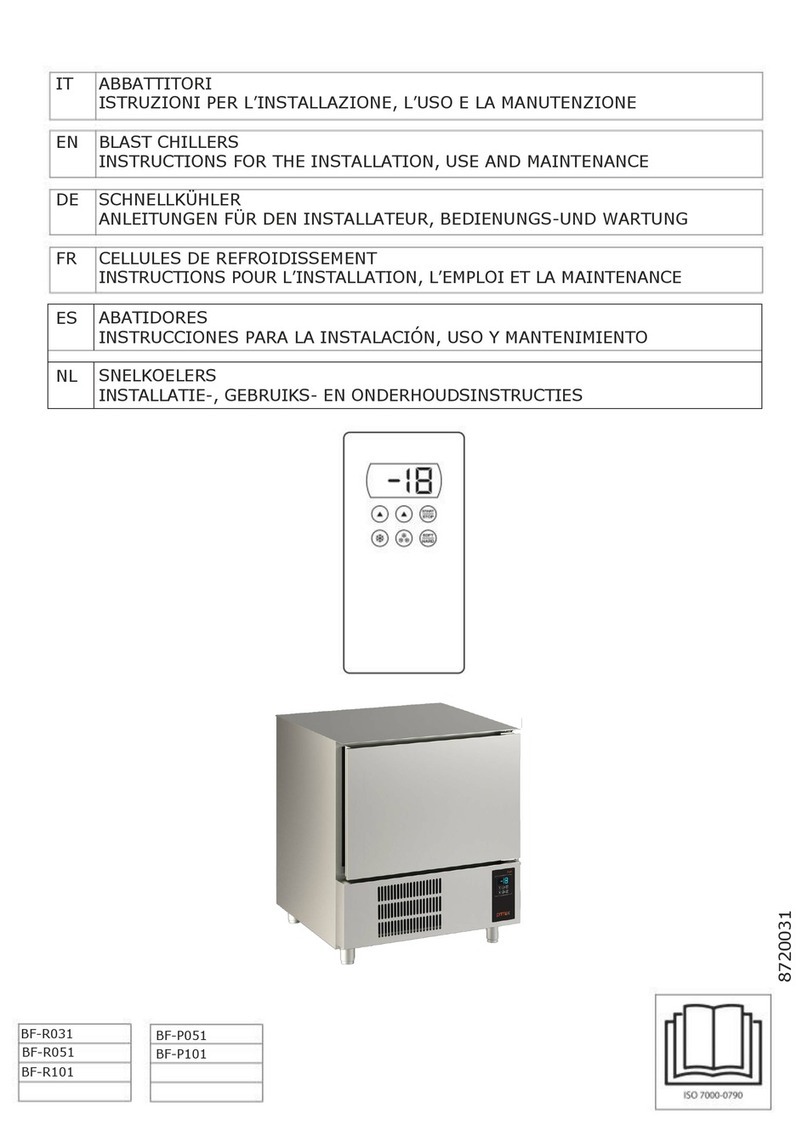
Primax
Primax BF-R031 INSTRUCTIONS FOR THE INSTALLATION, USE AND MAINTENANCE

TECO
TECO Tank TK 150 Guideline
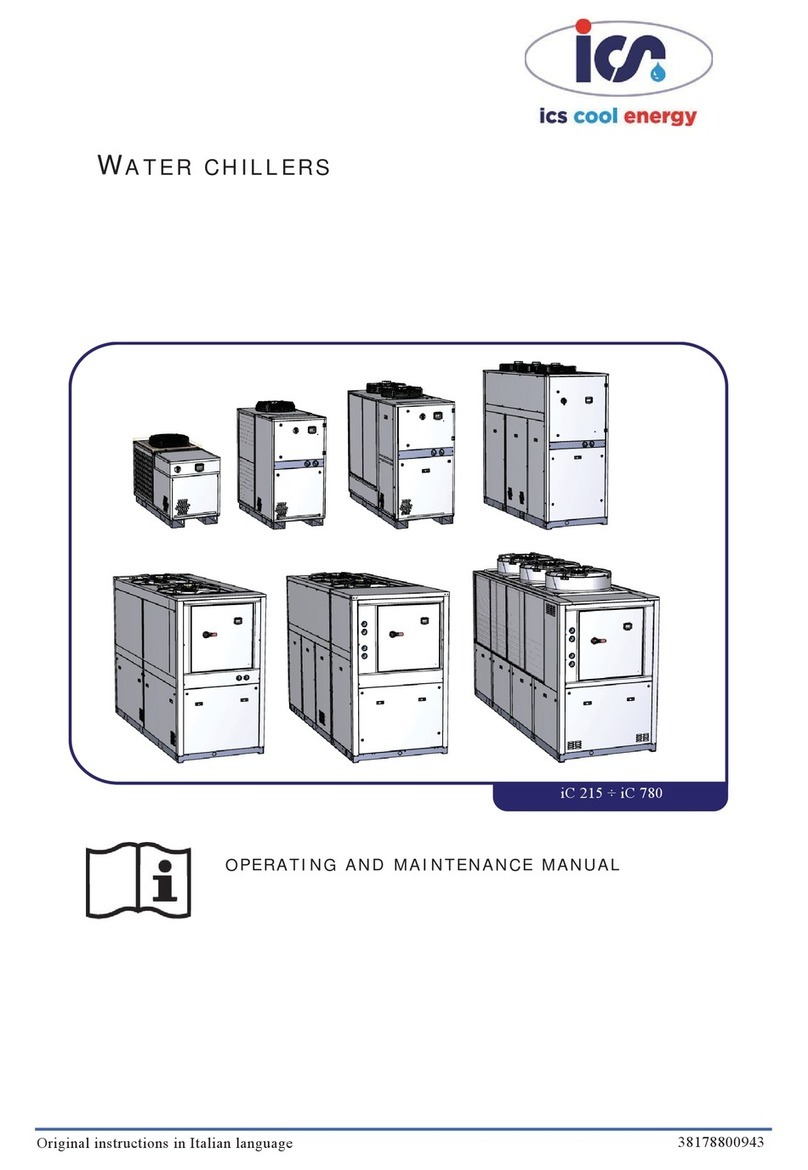
ICS
ICS iC 215 Operating and maintenance manual
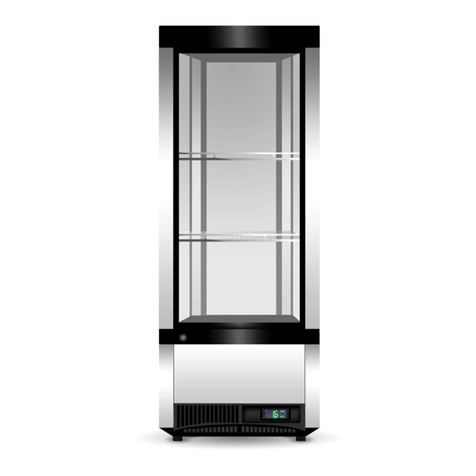
Skope
Skope Serene SC112N-A Service manual
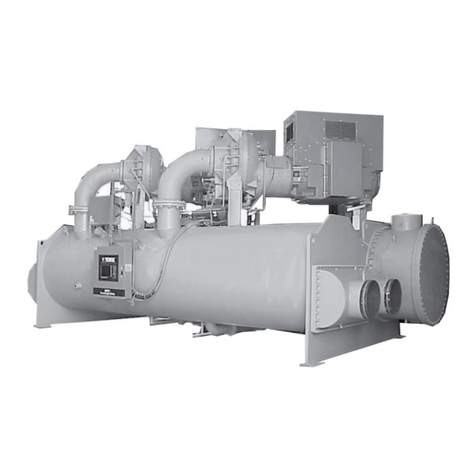
Johnson Controls
Johnson Controls York YD manual
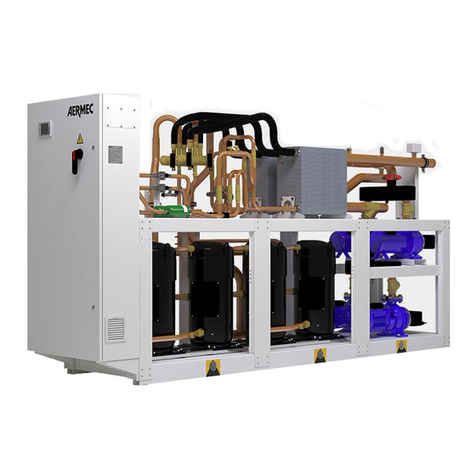
AERMEC
AERMEC NXW 0500 Technical manual installation maintenance

Haier
Haier CA0035AANC Installation, operation and technical manual
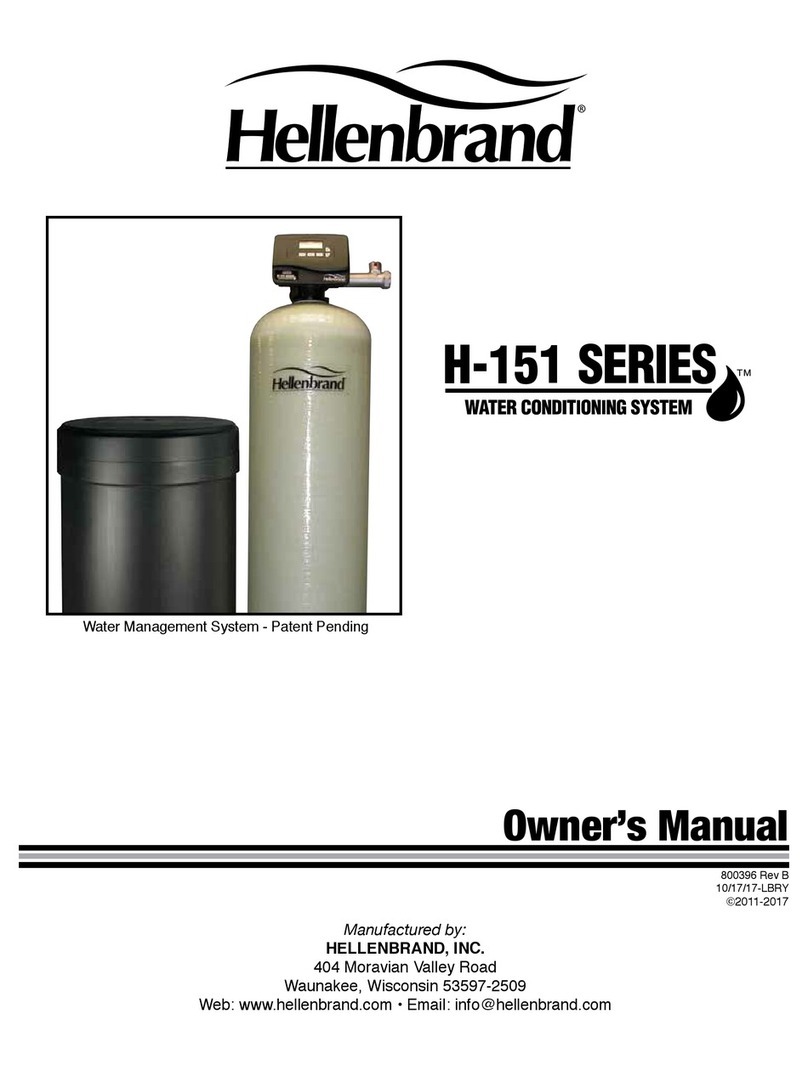
Hellenbrand
Hellenbrand H-151 Series owner's manual
